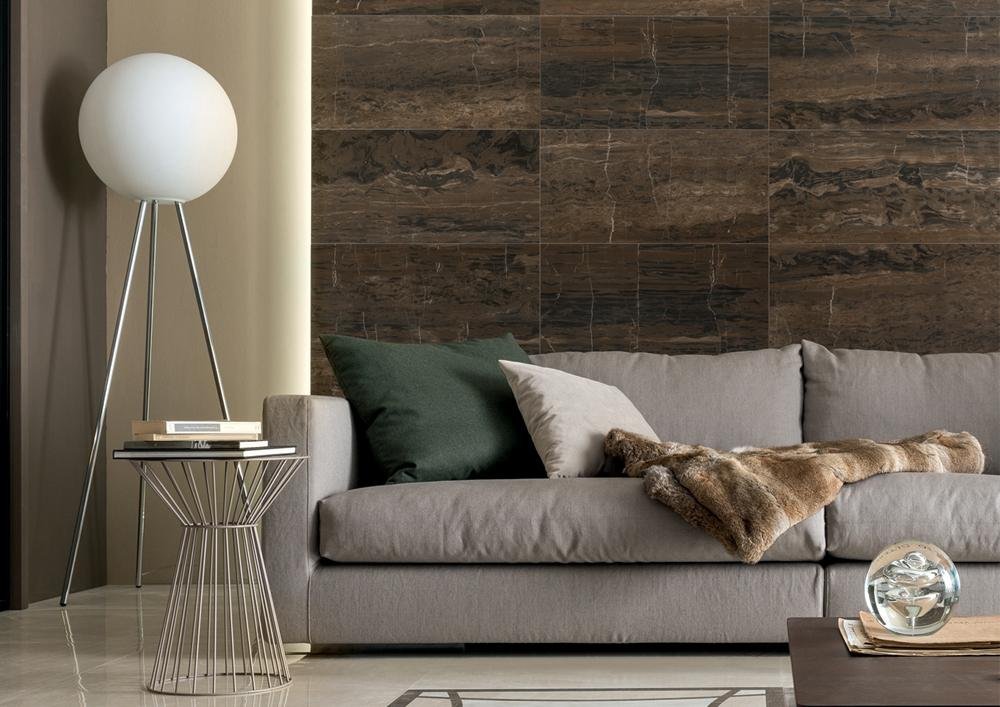Ceramic With A Metallic Finish
Ceramic tiles with a metallic finish are all the rage. It perfectly meets the requirements of minimalism, a style characterized by the purity of forms, the lack of details and decorations. Here the principle of “less is more” finds its application, dominated by flat surfaces, uniform finishes, straight lines, elementary colors, cold and rough materials such as ceramic sinks, which reproduce various metallic alloys.
The tough, functional, and at the same time impeccably elegant interior stands out with the brilliance of steel, aluminum, copper, and titanium inclusions. And at the same time, there is not a single metal alloy here: the original effect is created by the metallic textures on the ceramic tiles, highly valued by fans of avant-garde and modern urban aesthetics.
To a lesser extent, but also with great success, Ceramic tiles with a metallic finish are used to create complex ornamental compositions inlaid with copper and gold. The artisan effect brings sophistication to sophisticated baroque interiors.

In the development of metalized tiles, the color effects of iron, steel, copper, aluminum, and even titanium are used, in pure form or in various alloys, with different levels of oxidation. From these effects, it was possible to develop a wide range of enamels for finishing various ceramic surfaces.
From the creative union of metallurgy and ceramic production, a new concept was born of recreating pure materials in ceramic, recognizable not only by sight but also by touch. In the new enamels, materials have been applied whose use until recently seemed impossible. They allow, for example, to reproduce stainless steel with great precision, without sacrificing the excellent acoustic and thermal insulation properties of ceramic tiles.
Metallic tiles occupy a special place in the collections of a large number of manufacturers. The more attention paid to innovations in the company, the broader the choice of such coatings that it can offer to the consumer.
The variety of metalized coatings, which is easy to verify, poses a problem of choice for the consumer. What coating is more suitable?
Here, as always, there are and cannot be other restrictions, this is a matter of taste. However, in general, metallic finishes are especially suitable for cutting-edge interiors.
They find their most organic application in shopping centers for young people. In shops and salons, where aesthetic quality and technical excellence must go hand in hand, floor and wall coverings are designed to attract visitors, they serve as a means of personalizing an establishment, while remaining extremely durable, adapted for intensive use. Pedestrian safety is also of great importance, thanks to special non-slip treatment.
As for housing, here metallic ceramic is most often used to decorate loft-style apartments, in which it is necessary to create a calm and serious atmosphere, consistent with the character and temperament of the people living in such apartments. People from the liberal professions with a penchant for unpretentious interiors also often use such coverings to decorate their offices. The new porcelain slabs are widely used in open spaces. Its atomic bonds are much stronger than those of metals. Therefore, it does not rust and perfectly resists overheating, sudden changes in temperature, and the effects of corrosive substances.
When creating large architectural structures, ceramic tiles have an undeniable advantage over natural stone and aluminum-based materials.
In all these cases, whether for interior decoration or open spaces, architects and designers are increasingly betting on metallic ceramics. They value it highly as a material with wide possibilities, as an ideal medium to convey certain sensations.
If tiles can be attractive for many reasons, then ceramic tiles with a metallic effect, due to their novelty and relevance, simply do not need advertising.
The appearance of the metallic ceramic tile was preceded by a whole decade of scientific research and development. During this period, manufacturers of glazes and ceramic coatings, in cooperation with state research institutes, invested considerable funds in research, resulting in coatings with new surface textures, new reflections, new volumes.
These results were not achieved immediately. The first high-quality metalized frits appeared in 2000. They were enamels with a metallic effect, suitable for single firing, used in the production of porcelain stoneware. However, in the first years of their existence, these materials went unnoticed.





